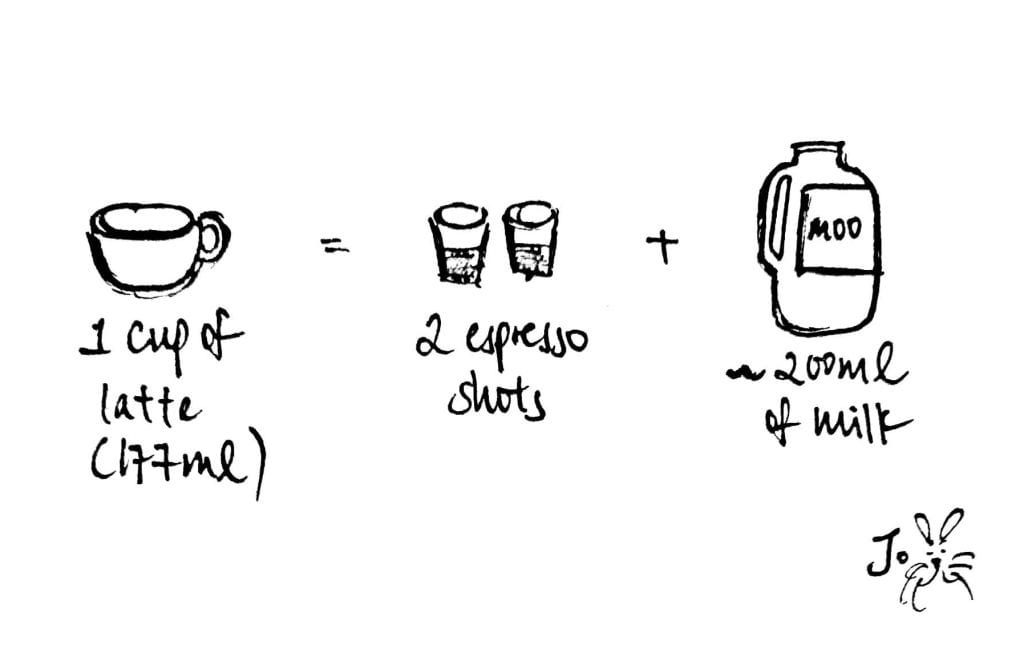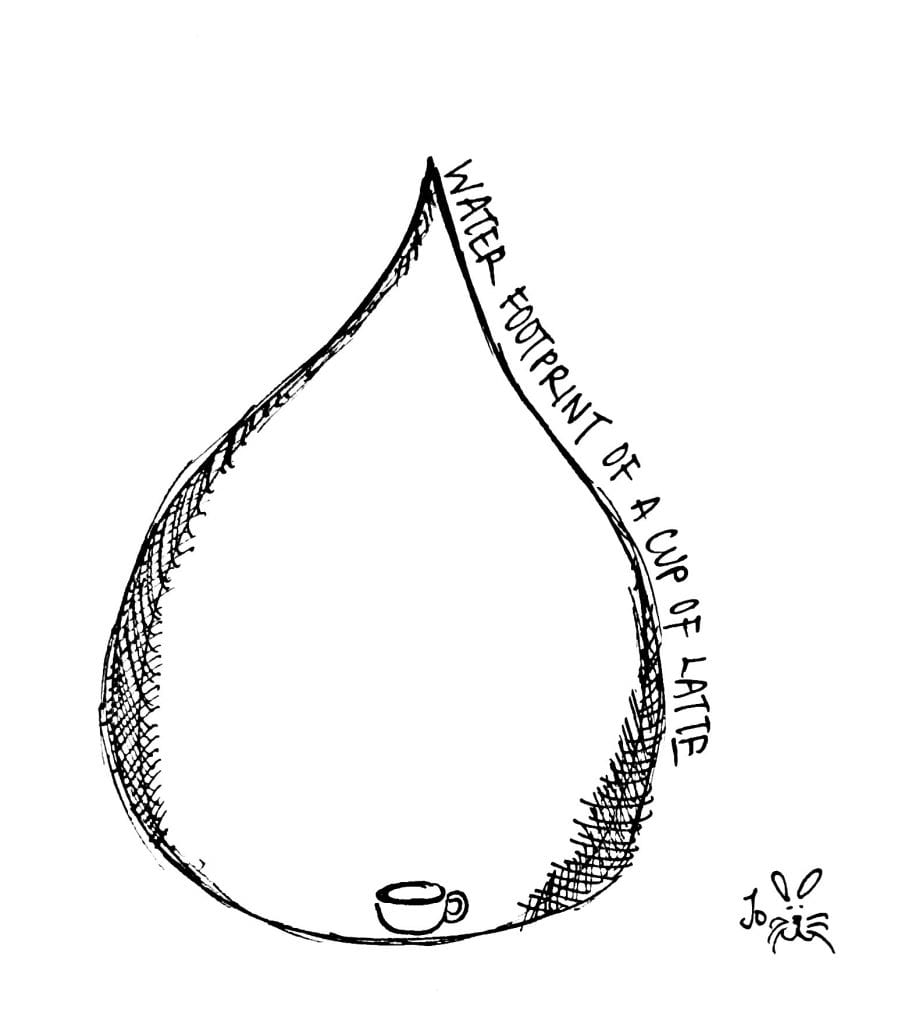Previously, I’ve blogged about waste production in my café and shared some ways which it has implemented to reduce waste. In this post, we shall take a look at drinks sold at the café, particularly the hot café latte.
While cashiering, I’ve always received questions from customers.
‘How much is a cup of latte?’
Without much hesitation, I’ll reply them ‘It’s five dollars’.
However, after attending the lecture on freshwater impacts, I’d hesitate to answer that a cup of latte only costs five dollars. The word cost has much more meaning to it. Not only does it include the final amount of money the customer has to pay, it also includes the value of resources used in the production of this final product. So, to find out how much a cup of latte actually costs, I will be examining its water footprint.
What goes into a cup of latte?
The water footprint of 2 espresso shots traces all the way back to its source – coffee beans, and how it has been grown. My café uses two types of coffee beans, one out of which my manager and co-workers are unsure of. As such, the calculations will be based on the coffee beans from Mexico alone. While I was researching, I chanced upon this article that had a clear breakdown of the steps in the production of coffee beans. It concluded that 1kg of coffee grounds requires approximately 164.85 litres of water. That’s about 1114 glasses of water, enough water to feed you for 139 days if you were to drink 8 glasses a day! To produce two espresso shots, it takes about 18g of coffee powder. That equates to approximately 2.97 L of water.
But let’s not forget about the milk needed in latte as well. We used Meiji full cream milk which is a product from Thailand (not Japan!). From this research paper, it concluded that 366.22kg of water is required to produce 1 kg of milk. That means, for every 200ml of milk used, 75.48 L of water is wasted.
As such, 1 cup of café latte = 75.48 L + 2.97 L = 78.45 L of water footprint.
However, this is merely the water footprint of producing one cup of latte! Let’s not forget the carbon footprint produced in the process. While preparing a cup of latte, energy is also required for the coffee machine to extract the espresso and to power the pitcher rinser. These two items also require water when they are used. As such, a cup of latte has in fact a lot of costs tied to it – water footprint, carbon footprint and energy use.
After knowing how much a latte costs, will I reduce my consumption of it? Yes. I’ll limit myself to only one cup of latte at work, even if I’m tempted to practice my latte art skills! What about you? Will you still drink your favourite latte?





Sarah-Ann Tham October 9, 2020
Hi Jo, it’s fascinating to find out the environmental footprint of a cup of coffee! While I do not drink coffee myself, how much do you think switching to more sustainable alternatives/ingredients would help to reduce the environmental footprint of coffee?
jolee2001 October 9, 2020 — Post Author
Hello Sarah-Ann 🙂
I think by switching to more sustainable alternatives like soy milk, it can help to reduce the water and carbon footprint of coffee. That’s because soy milk is produced from soy crops, unlike cow milk which is produced by cows. The carbon footprint of growing soya bean crops is far lower than that needed to raise cattles, as well as that needed to grow food for the cattle. (Check out this link to see how much more emissions and water is produced and used respectively in the production of dairy milk, compared to other milk) In fact, simply changing the drink option to an americano/black coffee can also help to greatly reduce the carbon and water footprint. That is so as an americano only requires the espresso shot and a cup of water. The carbon emissions and water needed to grow soya crops or livestocks can be omitted since milk is not used! However, just by switching to an alternative may not necessarily reduce the environmental footprint in the long run. The frequency of coffee consumption can also impact the environmental footprint even if one is consuming more sustainable alternatives. For example, if I were to consume one cup of americano every day, it would likely incur an even larger environmental footprint than having a cup of latte once a week! As such, though it would be good to switch to more sustainable ingredients, we would also need to control our frequency of coffee consumption. That would ensure that our efforts in switching to alternatives are not wasted, and can successfully reduce the environmental footprint of coffee.
– Jo
itfigures52 October 11, 2020
Hey Jo,
I’m more of a mocha guy myself, but I’d imagine it would probably have a similar, if not larger, carbon and water footprint compared to a latte! I really enjoyed the different perspective you presented on cost! It made me realise how I always equate it to monetary value alone and nothing else.
Perhaps if there were a system in place to evaluate the environmental footprint of a product, there may be a way to account for it in the costs of goods and services!
Cheers!
Joseph Wee
jolee2001 October 11, 2020 — Post Author
Hello Jospeh:)
Glad that I’ve provided you a new perspective! That sounds like a good idea – to have a system to account for the environmental footprint of products in their costs. That could remind consumers of the impact of consuming a certain good (When the good has a high environmental footprint, it will be priced higher). In this way, consumers can make a more conscious decision while purchasing goods. Since we are more likely to hold back on more expensive goods, having this system in place could possibly help in reducing the consumption of goods with high environmental footprint!
– Jo
ENV3102 October 12, 2020
Jo, this post is AWESOME !!!
What a fantastic assignment this is turning out to be. I’m so proud of you !
jc
jolee2001 October 12, 2020 — Post Author
Hi Dr Coleman,
Thank you so much!
– Jo